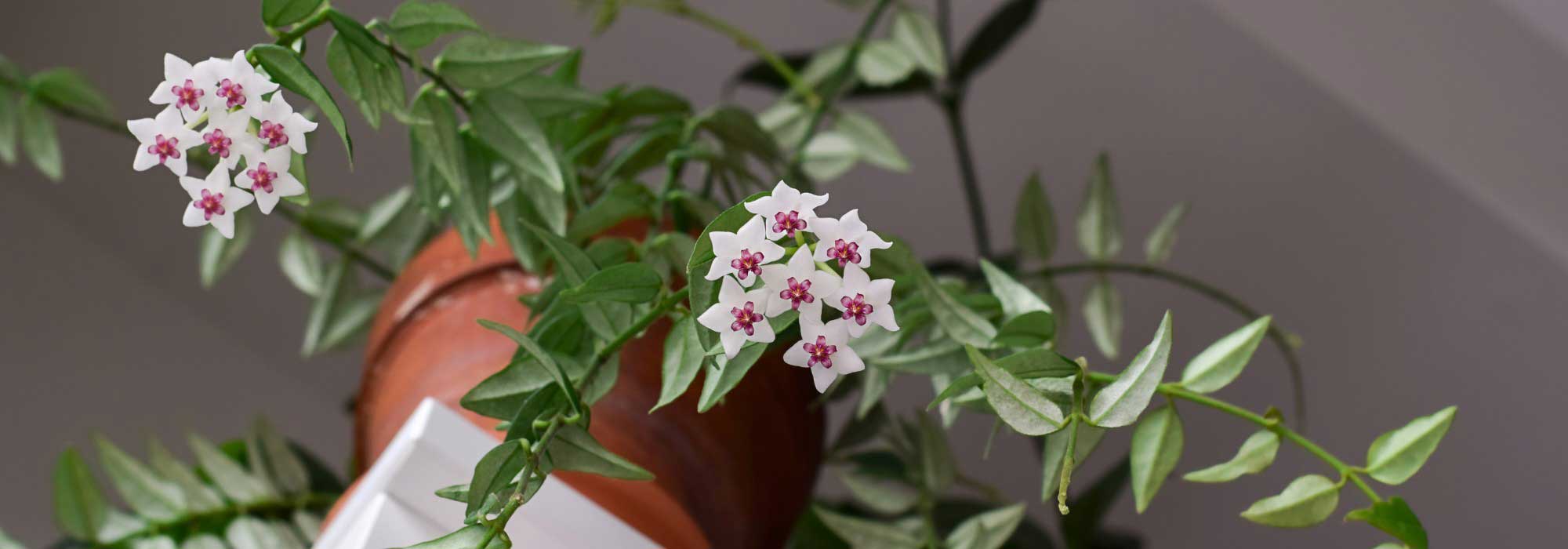
Hoya, Porcelain flower : cultivation and care
Contents
The Hoya in a nutshell
- The Hoya is a beautiful indoor plant with star-shaped, waxy flowers
- Its foliage is very decorative, green or beautifully variegated, sometimes heart-shaped (Hoya kerrii)
- Some varieties form climbing or trailing stems, making them ideal for hanging baskets!
- The flowers often release a pleasant fragrance
The word from our expert
The Hoya, often nicknamed “porcelain flower” or “wax plant”, is a prized houseplant for its decorative foliage and stunning fragrant flowers. Belonging to the Apocynaceae family, this tropical plant is cherished both for its easy care and its ability to bloom abundantly under the right conditions.
Native to Southeast Asia, Australia, and the Pacific Islands, the Hoya encompasses numerous varieties with green or variegated foliage, lanceolate or heart-shaped (like the Hoya kerrii). They often form long, flexible stems, making them highly decorative when hung or trained on a support. Their thick, glossy foliage, along with their clusters of star-shaped, waxy flowers, gives them a unique charm.
Very popular among houseplant enthusiasts, the Hoya is an ideal choice for those seeking a resilient, original, and highly decorative plant to enhance an office, living room, or apartment.
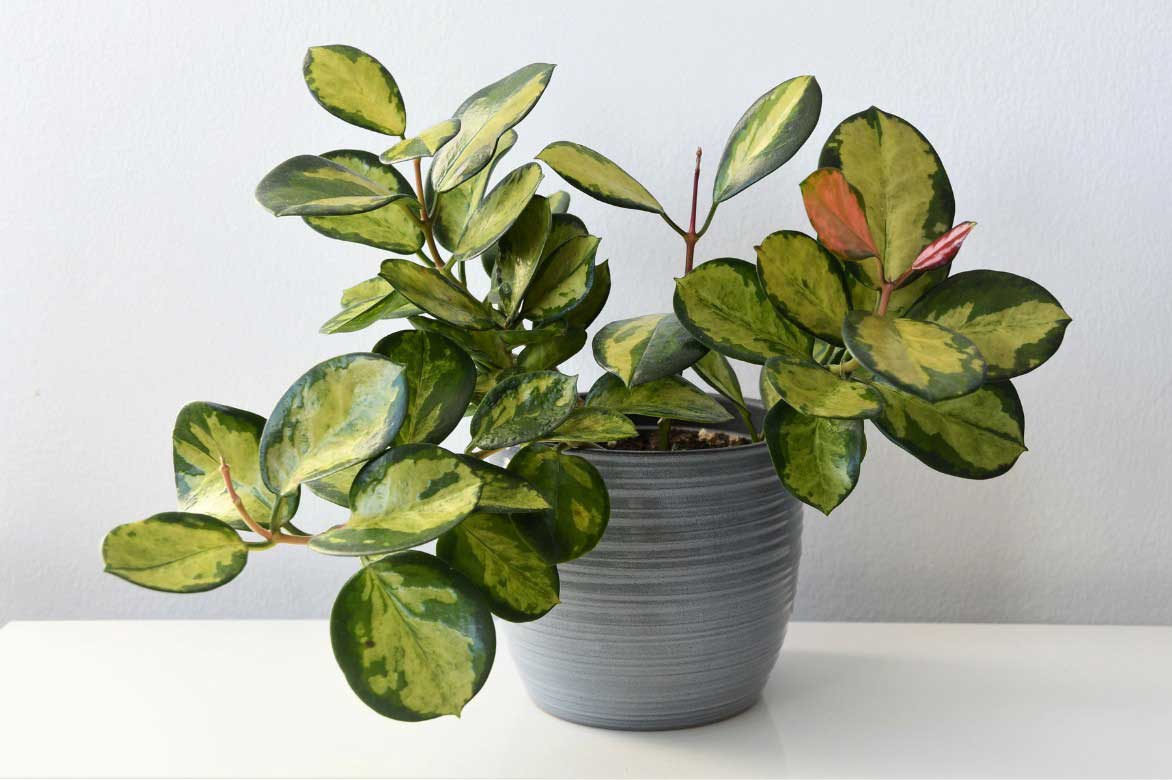
Hoya australis ‘Lisa’
Botany and description
Botanical data
- Latin name Hoya sp.
- Family Apocynaceae
- Common name Porcelain flower, Wax plant
- Flowering From spring to autumn, depending on the variety and growing conditions
- Height Up to 3 m for climbing or trailing varieties
- Exposure Bright but without direct sunlight
- Soil type Light and well-draining
- Hardiness Frost-tender (minimum 10 °C)
The Hoya originates from the tropical and subtropical regions of Southeast Asia, India, Australia, and the Pacific Islands. It is mainly found in humid forests, where it often grows as an epiphyte, clinging to tree trunks with its voluble stems. This ability to grow without soil, absorbing moisture from the air, explains its tolerance for light and well-draining soils when cultivated indoors.
The Hoya belongs to the botanical family Apocynaceae, like the periwinkle (Vinca minor) and the oleander (Nerium oleander). This family also includes many tropical plants, some of which are frequently grown indoors, such as Ceropegia, Adenium, or Pachypodium. Most plants in this family are toxic, containing alkaloids.
Hoyas were named by Robert Brown in 1810, a Scotsman who was among the first to introduce Hoyas into cultivation. He named them in honour of his friend Thomas Hoy, head gardener to the Duke of Northumberland.
The genus Hoya comprises over 500 species, not to mention the numerous hybrids and cultivars developed by enthusiasts of this fascinating plant. Hoyas thus offer exceptional diversity in terms of foliage, flowering, and habit, allowing everyone to find the variety that suits them!
The Hoya forms long, flexible stems, which can be trailing (Hoya gracilis, Hoya linearis…), or climbing (like the Hoya australis). It can be trained on a stake or arch, or grown in a hanging basket, from which its flexible stems will gracefully trail. The length of the stems varies by species, but they can sometimes reach several metres under optimal growing conditions.
The foliage of the Hoya is one of its most captivating features. Its leaves are generally thick and waxy. Their colour is most often a deep green, though there are many variegated varieties. For example, in Hoya carnosa ‘Tricolor’ and Hoya burtoniae ‘Variegata’, young leaves are tinged with red or pink, later turning cream-white to yellow, edged with green. In the Hoya ‘Flamingo Dream’, this variegation is reversed, with dark green leaves edged in cream-white to pink. In the Hoya callistophylla, the leaves have a light green lamina, marbled with dark green veins, creating a stunning contrast! Finally, some hoyas feature silvery foliage, like the variety Hoya krohniana ‘Eskimo’.
The leaves of the Hoya are most often lanceolate, but again, some species stand out. For example, the Hoya wayetii has very fine, elongated leaves, the Hoya retusa bears thread-like leaves, while the Hoya kerrii boasts beautiful heart-shaped leaves (earning it the nickname “heart plant”)! Its leaves are succulent, allowing it to store water and withstand drought. For this species, watering can therefore be less frequent than for other species! It is also available in a variegated form: Hoya kerrii ‘Variegata’, with leaves edged in yellow, visually enhancing their unique shape. However, in terms of leaf shape, the most surprising is undoubtedly the Hoya carnosa ‘Compacta’, which has leaves curled in on themselves!
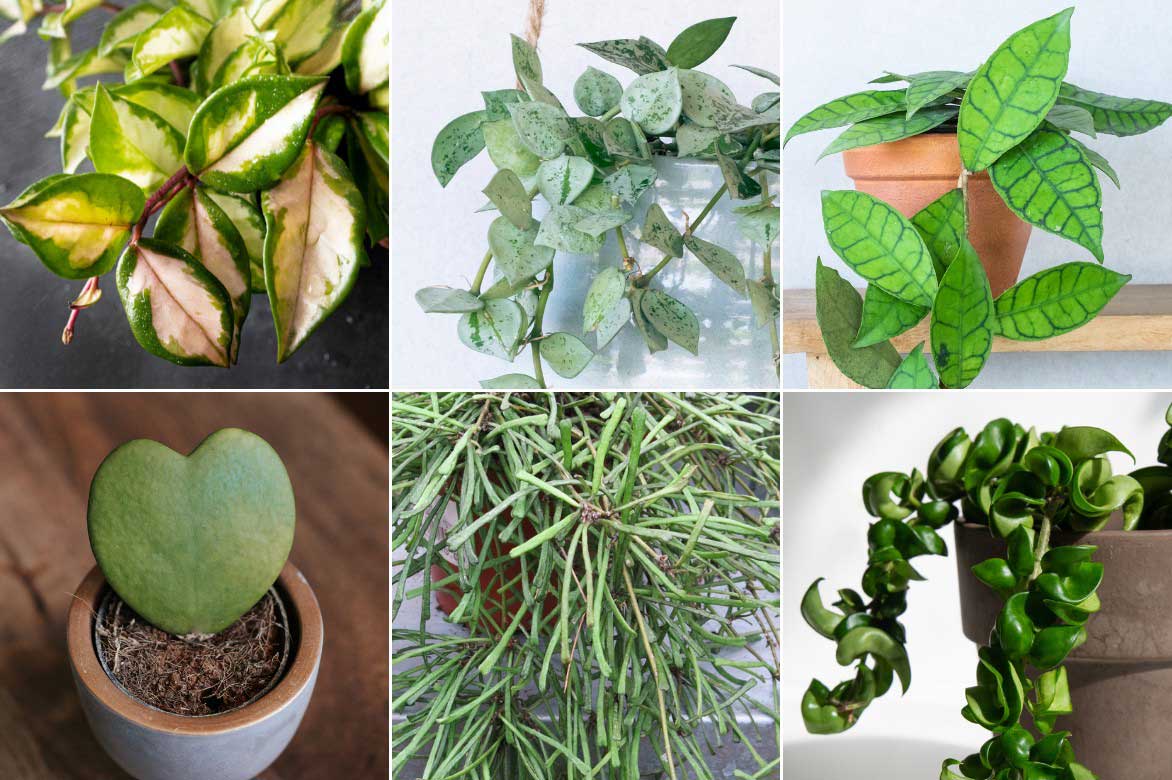
The Hoya offers great diversity in foliage colours and shapes. Hoya carnosa ‘Tricolor’, Hoya lacunosa ‘Silver’, Hoya callistophylla, Hoya kerrii, Hoya retusa and Hoya carnosa ‘Compacta’
The Hoya is also highly prized for its spectacular flowering! It most often blooms in spring or summer, though this also depends on the variety and growing conditions. It may even flower several times a year! Its flowers form small stars grouped in umbels (sometimes up to 30 flowers per umbel), creating beautiful little bouquets of flowers. These are made up of five waxy petals, with a small crown (called the corona) in the centre, consisting of the pistil and stamens. The umbels are attached to the stem by a peduncle, which has the unique ability to bear flowers multiple times! It is therefore important not to cut this peduncle once the flowers have faded.
The colour of the flowers varies by species, but it is most often in white or pink tones. The flowers can thus be white with a pink or red centre (like in the Hoya bella and Hoya kerrii), or entirely pink (Hoya ‘Flamingo Dream’), but also cream-white, beige, yellow, dark red, purple, or even black…
The flowers emit an enchanting fragrance, often more intense in the evening (as in nature, they are pollinated by nocturnal insects). The scent varies by species and growing conditions (heat generally favours a stronger fragrance): it can evoke vanilla, cocoa, lily of the valley, almond…
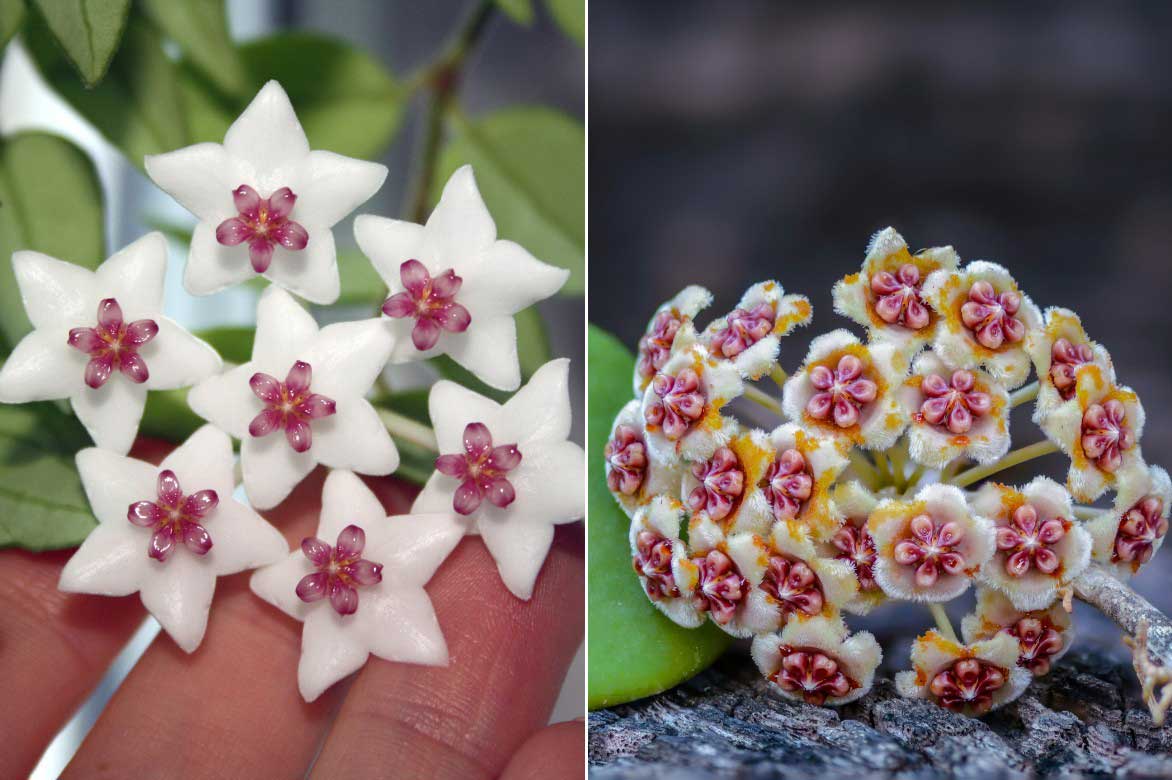
The Hoya is particularly prized for its very delicate flowering. On the left, the flowers of the Hoya bella, and on the right, those of the Hoya kerrii
The best varieties of Hoya
How to plant the Hoya?
Where to Place the Porcelain Flower?
As a tropical plant, the Hoya prefers a warm and bright environment, without intense direct sunlight. It will thrive in temperatures between 18°C and 25°C. The ideal spot is near an east or west-facing window, where it will enjoy bright, indirect light. Avoid direct afternoon sun, which could scorch its leaves, especially in delicate-leaved varieties. It will also appreciate being sheltered from cold drafts and temperature fluctuations. A humid room like a well-lit bathroom may suit certain species (e.g., Hoya linearis), but in general, the average humidity of a home is sufficient.
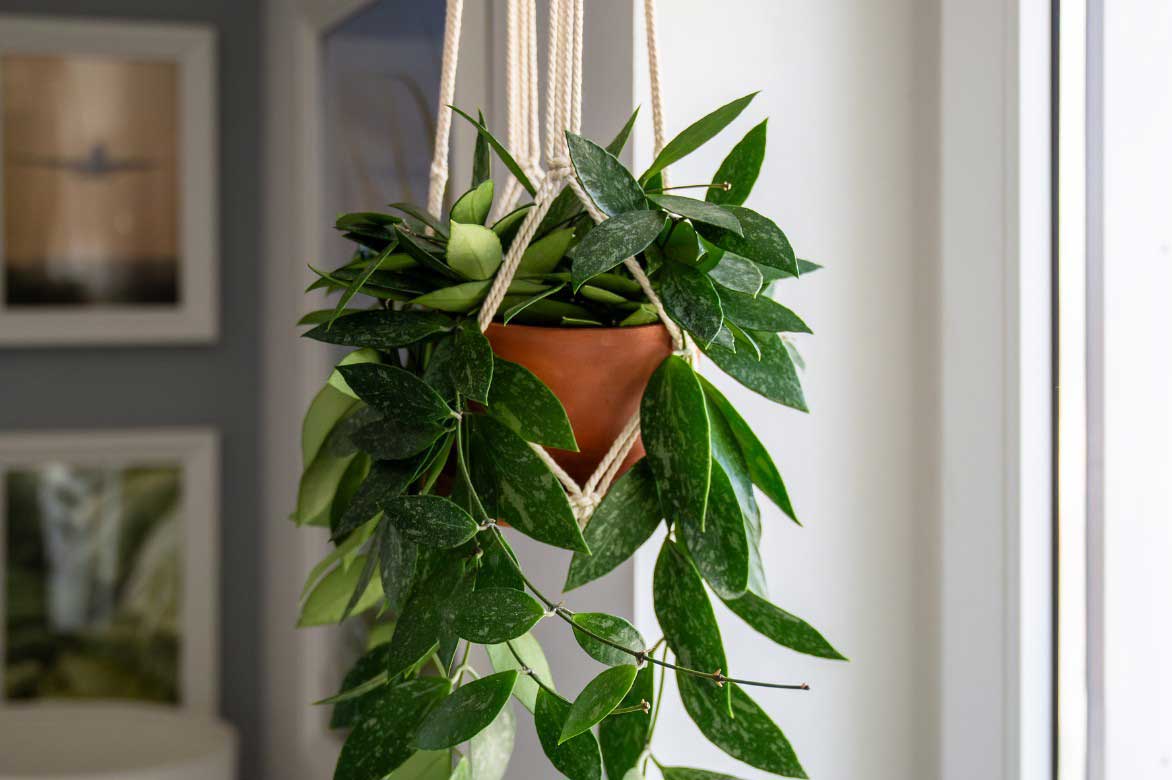
Place the Hoya in a bright spot, ideally near a window. Don’t hesitate to hang trailing varieties!
When to Plant the Hoya?
The Hoya can be planted or repotted in spring or early summer, when it enters its active growth phase. This allows it to establish roots well before winter.
Avoid repotting in autumn or winter, as the plant slows its growth during this period and would take longer to adapt to its new pot.
How to Plant It?
Choosing the Pot:
- Opt for a terracotta pot rather than plastic, as it promotes better root aeration.
- Ensure it has drainage holes to prevent excess moisture, which can cause root rot.
- A slightly snug pot encourages flowering, so avoid choosing one that’s too large.
Ideal Substrate:
The Hoya needs a light, well-draining substrate that isn’t too rich or compact. The substrate should allow good root aeration to prevent rot. You can use orchid compost mixed with perlite or create a homemade blend of light compost (about 40%), pine bark (20%), perlite (20%), and coconut fibre (20%).
Planting Steps:
- Fill the pot with the substrate, leaving enough space for the plant.
- Gently remove the Hoya from its old pot, taking care not to damage its roots.
- Place the plant in the pot and add substrate around the roots without compacting too much.
- Water lightly to moisten the substrate without soaking the roots.
After planting, allow the Hoya to adjust to its new environment for a few days before watering again.
How to Care for the Porcelain Flower?
The Hoya is a relatively easy-to-care-for houseplant, but to encourage its growth and improve its chances of flowering, it is essential to follow certain best practices in terms of watering, fertilisation, and exposure.
Watering: How often and how to water the Hoya?
The Hoya is a plant that tolerates drought relatively well thanks to its thick leaves, which can store water. However, improper watering can quickly become problematic. During the growth period, in spring and summer, we recommend watering it about once a week, while allowing the substrate to dry out between waterings. In autumn and winter, when the plant slows its growth, reduce watering to once every two or three weeks.
It is important to use water at room temperature, preferably non-calcareous, such as rainwater or filtered water. Watering should be thorough, but excess water must be allowed to drain to avoid stagnant water, the main cause of root rot. Pay special attention to signs of improper watering: overwatering results in soft or yellowing leaves, while underwatering can cause wilting and wrinkled foliage.
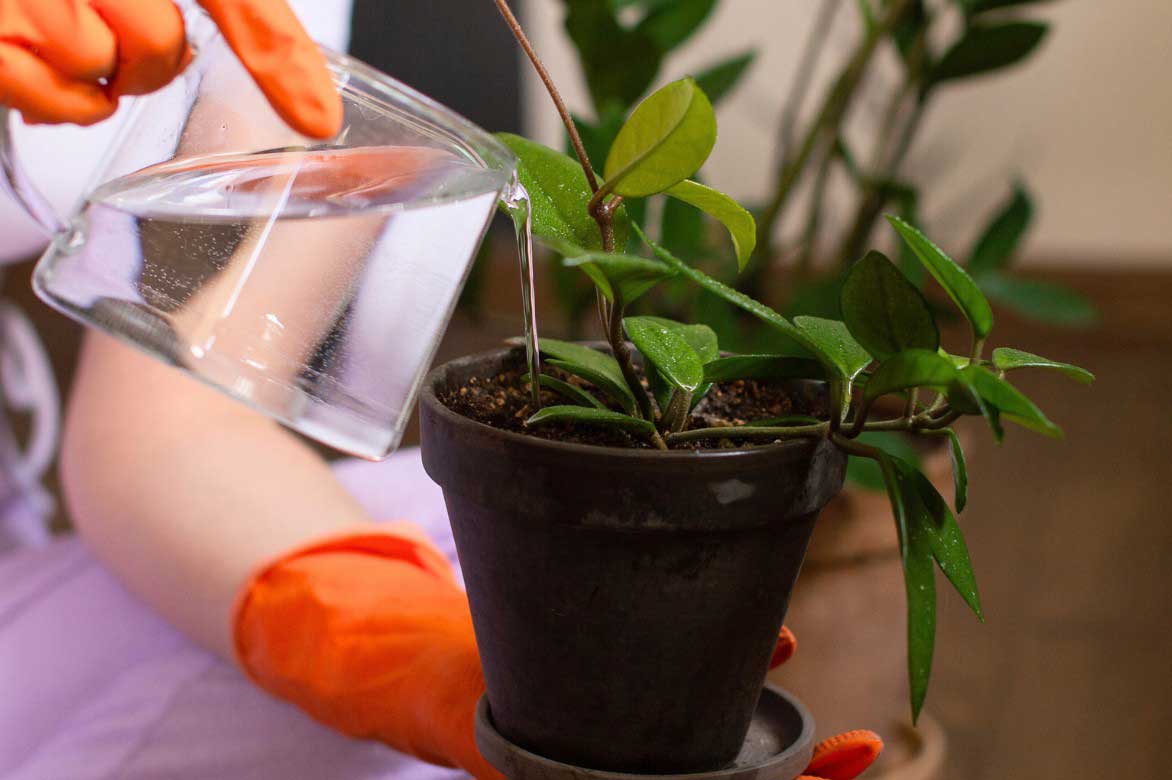
Remember to water the Hoya regularly
Fertilisation: What fertiliser to use for the Hoya?
To stimulate growth and encourage abundant flowering, it is recommended to fertilise the Hoya regularly. During the active growth period, in spring and summer, a liquid fertiliser for flowering plants, rich in phosphorus, can be applied every two to three weeks. An alternative is to use a balanced fertiliser, promoting both foliage development and flower production. On the other hand, in autumn and winter, it is best to suspend fertilisation, as the plant enters dormancy and no longer requires additional nutrients.
The use of organic fertilisers, such as liquid compost or nettle manure, can also be beneficial, provided they are not overused. Excessive fertilisation can indeed harm flowering by promoting excessive foliage growth at the expense of flowers.
How to prune the Hoya?
The Hoya does not require regular pruning, but some maintenance gestures help maintain a beautiful shape and stimulate flowering. It is advisable to remove yellowed or damaged leaves to encourage the growth of new shoots. To control its growth, especially in climbing varieties, lightly pruning overly long stems is possible. However, a crucial rule to follow is to never cut the flower stems after flowering, as the plant has the unique characteristic of reflowering on the same peduncles year after year. Excessive pruning could therefore compromise future flowering.
When pruning is necessary, it should be done with clean, sharp pruning shears to avoid unnecessary damage to the plant. A clean cut above a node encourages branching and the development of new stems, contributing to a denser and more harmonious habit.
The ideal environment: light, temperature, and humidity
The Hoya is a tropical plant that thrives in bright, indirect light. A spot near an east or west-facing window is ideal. If the plant is placed in direct sunlight, especially in a south-facing environment, it is recommended to filter the light with a sheer curtain to prevent leaf burn. Conversely, insufficient light can slow its growth and prevent flowering.
Regarding temperature, the Hoya thrives ideally between 18 and 25°C and cannot tolerate temperatures below 10°C. It is therefore important to keep it away from drafts and sudden temperature changes. Ambient humidity also plays a role in its well-being. Although it adapts to the dry air of our homes, a humidity level of 50 to 60% is optimal. In winter, when heating dries the air, it may be helpful to lightly mist its leaves or place a container of water nearby to increase humidity.
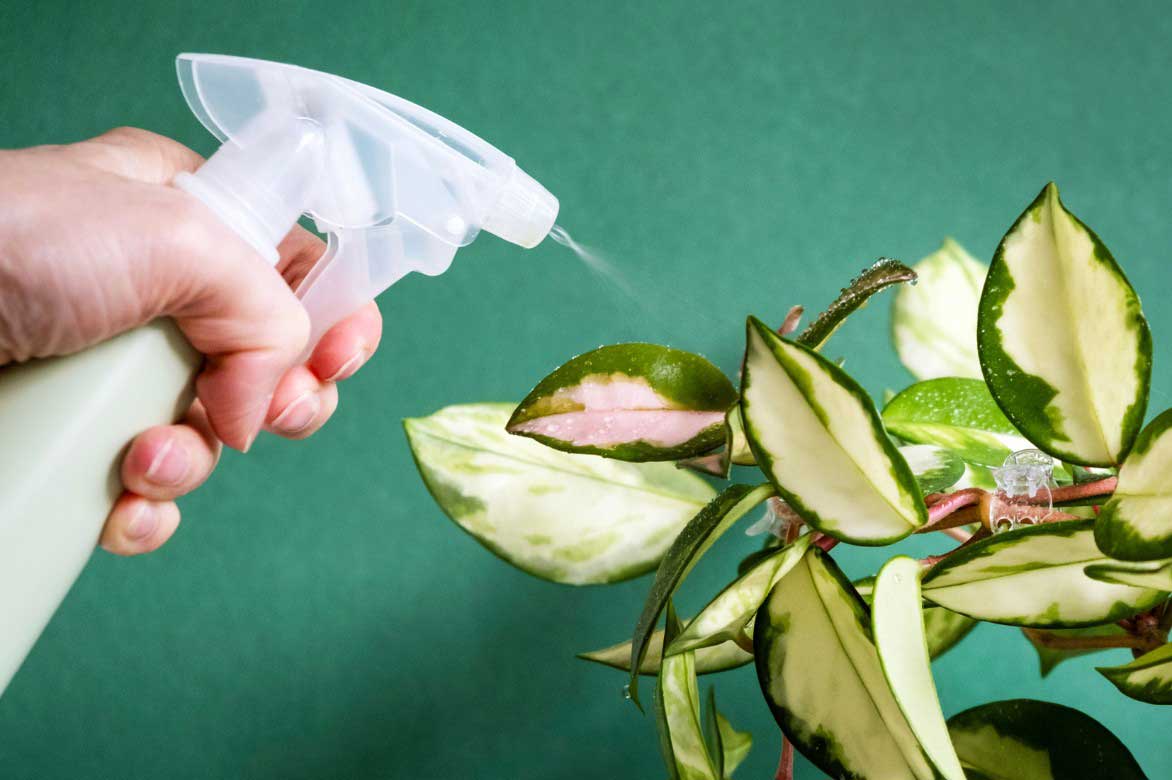
Your Hoya will appreciate occasional misting of its foliage!
Staking: how to guide its stems?
As the Hoya is a climbing or trailing plant depending on how it is cultivated, it can be guided according to the desired effect. For structured growth, it can be trained on a hoop, trellis, or stake. This technique helps direct its stems and encourages more uniform flowering. Conversely, if a more natural look is preferred, it can be left to grow in a hanging basket, where its long stems will form a beautiful cascading display.
When to repot the Hoya?
The Hoya does not need frequent repotting. Repotting every 2 to 3 years is sufficient, unless the roots outgrow the pot or the substrate becomes depleted. Each time, choose a pot slightly larger than the previous one.
Proper repotting promotes healthy growth and helps eliminate a substrate that has become too compact or nutrient-poor.
→ Read our detailed advice in How to repot a houseplant?
Diseases and Pests of the Hoya
Although the Hoya is a robust plant and relatively resistant to diseases, it can still be susceptible to certain problems when grown in unsuitable conditions. Excess moisture, poor air circulation, or parasitic infestations can compromise its growth and flowering. It is therefore essential to recognise the signs of diseases and infestations to act quickly and preserve the plant’s health.
Common Diseases of the Hoya
One of the most common problems in Hoyas is root rot, usually caused by overwatering and poor substrate drainage. When the roots are constantly wet, they begin to necrotise and can no longer absorb the nutrients the plant needs. This problem manifests as yellowing leaves, general wilting, and sometimes an unpleasant odour from the soil. To avoid this situation, it is crucial to let the substrate dry out between waterings and to use a well-draining substrate and a pot with drainage holes to allow excess water to escape. If rot is already present, it is advisable to repot the plant, removing damaged roots and using fresh, aerated substrate.
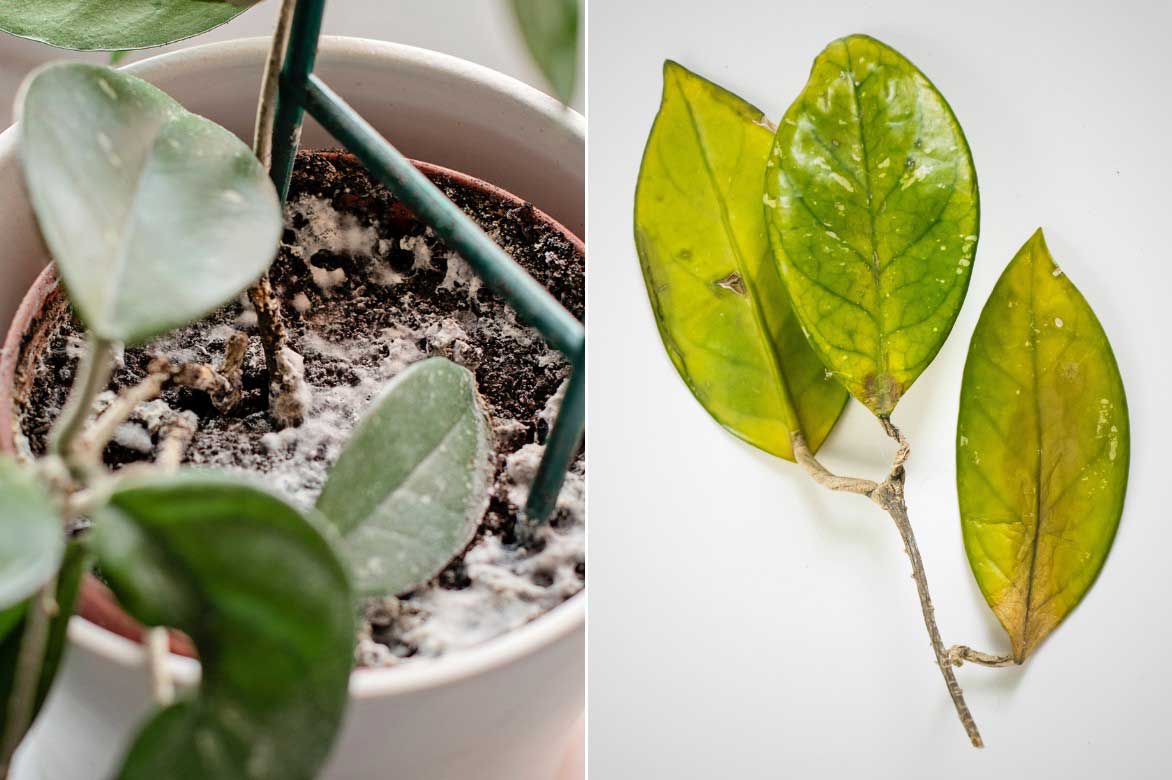
Excess moisture can lead to the appearance of fungi on the substrate surface and yellowing foliage.
Hoyas can also be affected by powdery mildew, a fungus that develops due to excessive humidity and poor air circulation. This disease is recognisable by a whitish deposit on the leaves, which may then deform and fall prematurely. To prevent its appearance, it is recommended to avoid wetting the foliage when watering and to ventilate the room where the plant is located regularly. In case of an attack, a treatment based on sulphur or baking soda diluted in water can be applied to limit the spread of the fungus.
Pests of the Hoya
Several harmful insects can attack the Hoya, including mealybugs, aphids, and spider mites. Mealybugs are particularly dreaded parasites, as they attach themselves to the stems and under the leaves, forming small cottony clusters. They weaken the plant by sucking its sap, causing slowed growth and yellowing foliage. To get rid of them, you can use a cotton pad soaked in 70% alcohol to clean infested areas or apply a treatment based on black soap diluted in water.
Aphids, although less common, can also colonise young shoots and weaken the plant by sucking its sap. They often leave behind a sticky substance called honeydew, which promotes the development of sooty mould, a blackish fungus that disfigures the foliage and hinders photosynthesis. To eliminate them, spray black soap on infested areas (15 to 30 g of black soap diluted in one litre of water).
Finally, spider mites are microscopic mites that usually appear when the air is too dry. Their presence is indicated by progressive yellowing of the leaves, accompanied by fine webs on the stems and under the foliage. To prevent their proliferation, it is recommended to increase ambient humidity by lightly misting the plant and avoiding overly hot and dry environments. If the infestation is advanced, a treatment based on neem oil or an organic miticide can be applied to eradicate these pests.
For more advice, feel free to consult our guides on mealybugs, aphids, and spider mites.
How to propagate Hoya?
The Hoya is a plant that propagates easily by cuttings, a simple and effective method to obtain new plants from an existing stem. This technique not only allows you to faithfully reproduce a variety you appreciate but also to exchange cuttings with other enthusiasts. Propagation by cuttings is the most common method, but other techniques, such as layering, can also be used to propagate the Hoya successfully.
Propagating Hoya by Cuttings
Propagation by cuttings is the simplest and quickest way to multiply the Hoya. It is best practised in spring or summer, when the plant is in full growth. To succeed with cuttings, it is important to choose a healthy and vigorous stem, bearing at least two to three nodes.
- Cut a stem section of about 10 to 15 cm with clean and disinfected pruning shears. It is recommended to make the cut just below a node, as this is where roots are most likely to form.
- Remove the lower leaves to prevent them from soaking in water or the substrate and rotting.
Once the cutting is prepared, you can root it in water or directly in a light substrate. Rooting in water is a very popular method, as it allows you to easily observe the emergence of roots:
- Place the stem in a glass of water at room temperature, ensuring that at least one node is submerged.
- The water should be changed regularly to prevent the proliferation of bacteria.
- After a few weeks, roots will begin to form. Once they reach about 3 to 5 cm, transplant the cutting into a pot with a well-draining substrate.
You can also plant the stems directly in pots filled with substrate:
- Plant the cutting directly in a mixture of light potting soil, perlite, and pine bark.
- Water moderately to maintain consistent moisture without overdoing it.
- To encourage rooting, place the cutting under a cloche or in a transparent plastic bag to create a greenhouse effect that maintains good humidity.
- After three to four weeks, the first roots will appear, and the plant will begin to develop new shoots.
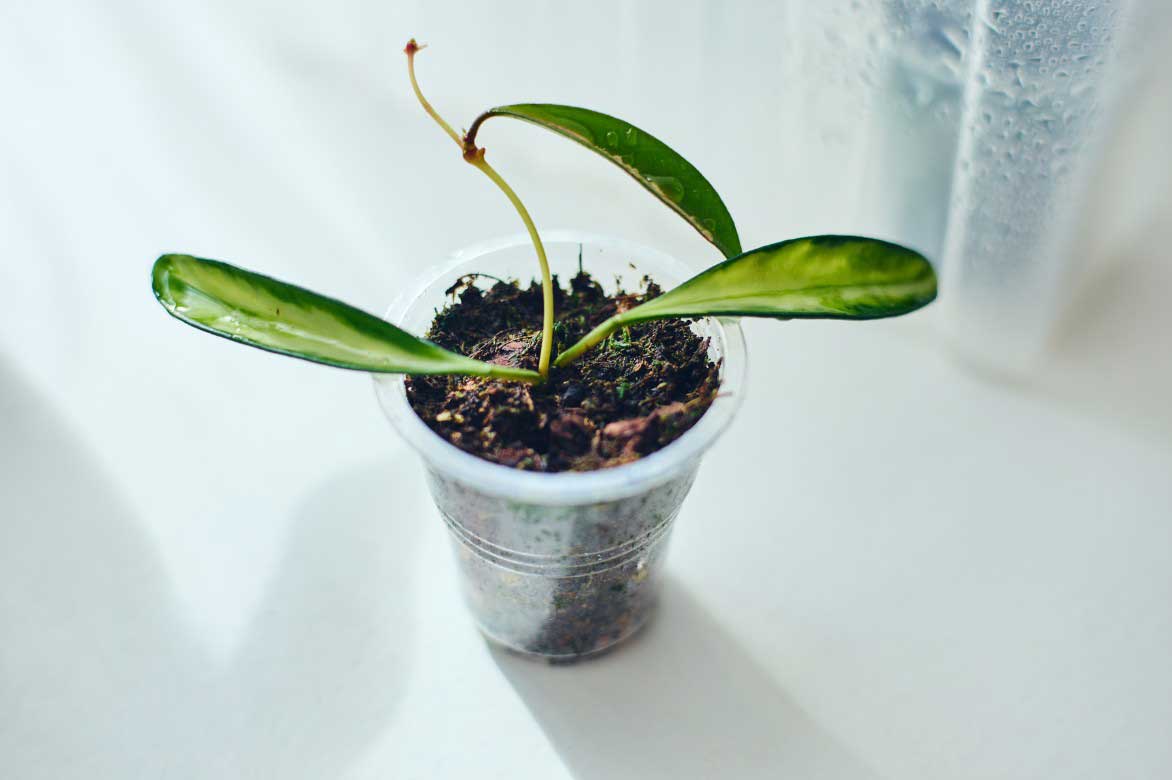
A Hoya cutting
Layering the Hoya
Layering is another effective technique for propagating the Hoya, especially for varieties with long and flexible stems. This method involves encouraging a stem to produce roots while still attached to the mother plant.
- Select a vigorous stem and lay it over a pot filled with substrate without detaching it from the plant.
- At the spot where you want roots to appear, lightly incise the stem to stimulate root emission.
- Cover this area with substrate and maintain regular moisture.
- After a few weeks, new roots will form at the layering site.
- Once well-rooted, separate the new plant from the mother plant and transplant it into an individual pot.
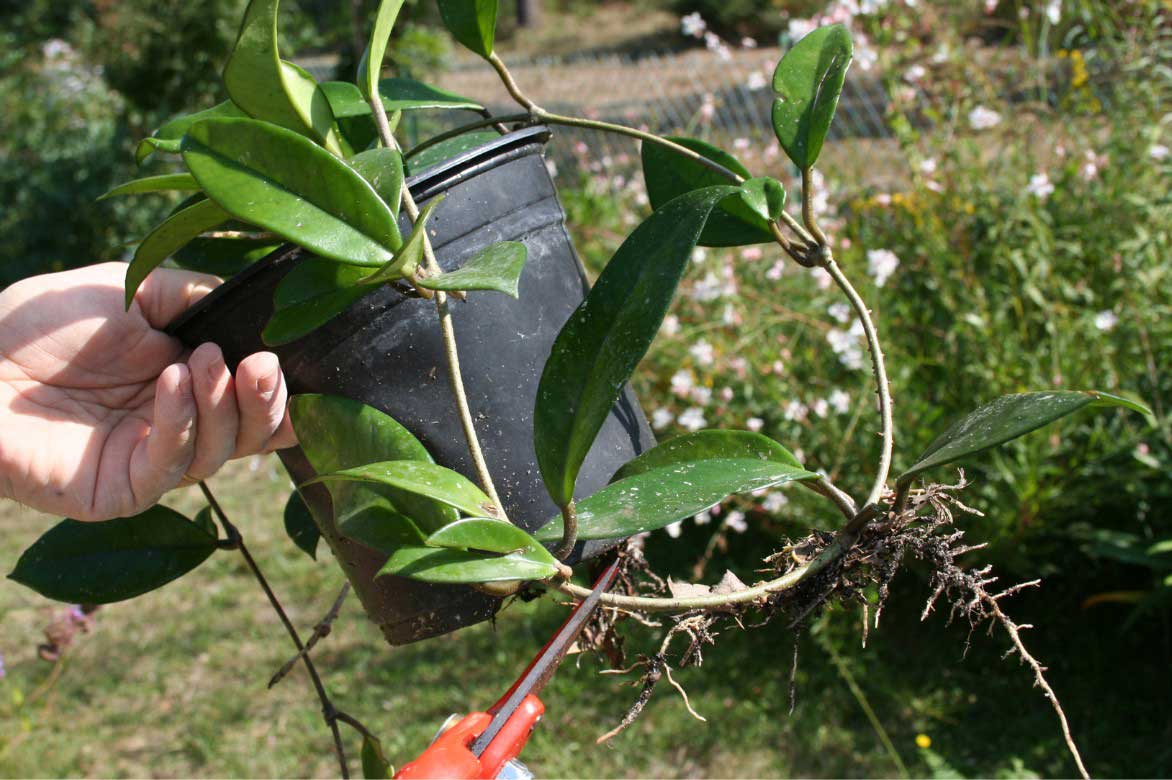
Layering a Hoya
How to showcase the Hoya and which plants to pair it with?
The Hoya pairs well with other tropical plants that thrive in bright light and a relatively humid atmosphere. To create a jungle vibe in your home, pair it with other lush-leaved plants like Monsteras, prized for their large, beautifully cut leaves. Also consider Alocasias, Calatheas, Chlorophytums, and Pothos. You can also pair it with orchids, which share similar requirements in terms of substrate and moderate watering.
If the Hoya is grown in a hanging planter, it can be paired with other trailing plants like Rhipsalis, Ceropegia, or Dischidia, which create a very aesthetic cascading effect. These plants share the same need for well-draining substrate and moderate watering. For an urban jungle effect, you can also combine it with Boston Ferns (Nephrolepis exaltata), which will add a touch of lightness with their delicate, finely cut foliage.
Don’t hesitate to mix different Hoya varieties, especially since they offer a great diversity of foliage and flowering! To play with contrasts, you could, for example, pair a Hoya carnosa ‘Krimson Queen’, with its white and pink variegated leaves, with a Hoya obovata, featuring rounded leaves speckled with silver. Similarly, a Hoya linearis, with its long pendulous stems, creates a beautiful balance alongside a Hoya compacta, whose twisted leaves add an original texture.
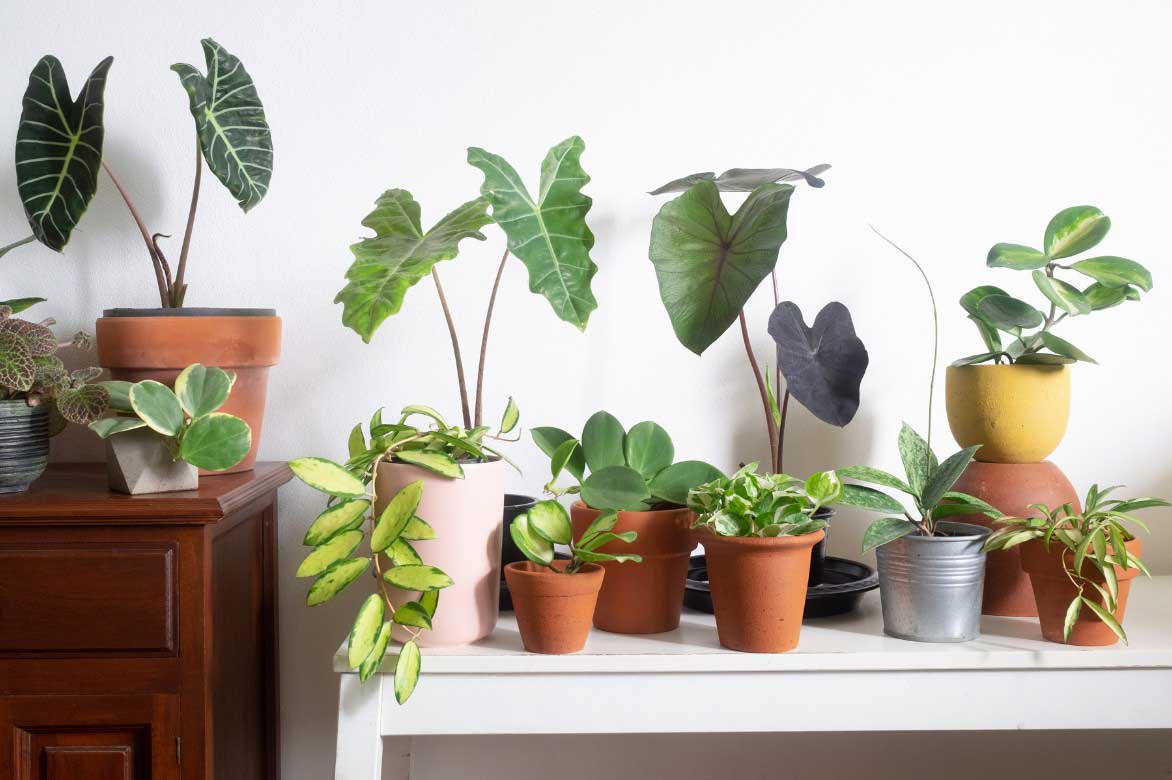
Feel free to mix different Hoya varieties and pair them with other decorative-leaved indoor plants, like Colocasias
Playing with supports and containers
The Hoya is a plant that lends itself to various decorative styles thanks to its ability to climb or trail in hanging planters. For a stunning effect, you can place a Hoya with long trailing stems, such as Hoya gracilis or Hoya krohniana, in a ceramic pot suspended by macramé weaving. On a wall shelf, a Hoya grown in a pot placed on a piece of driftwood will create a natural and minimalist effect.
Climbing Hoyas, like Hoya australis, can be trained onto a metal hoop, forming an elegant and refined plant structure. A bamboo trellis or wooden ladder also helps guide the stems while adding a decorative touch to the space.
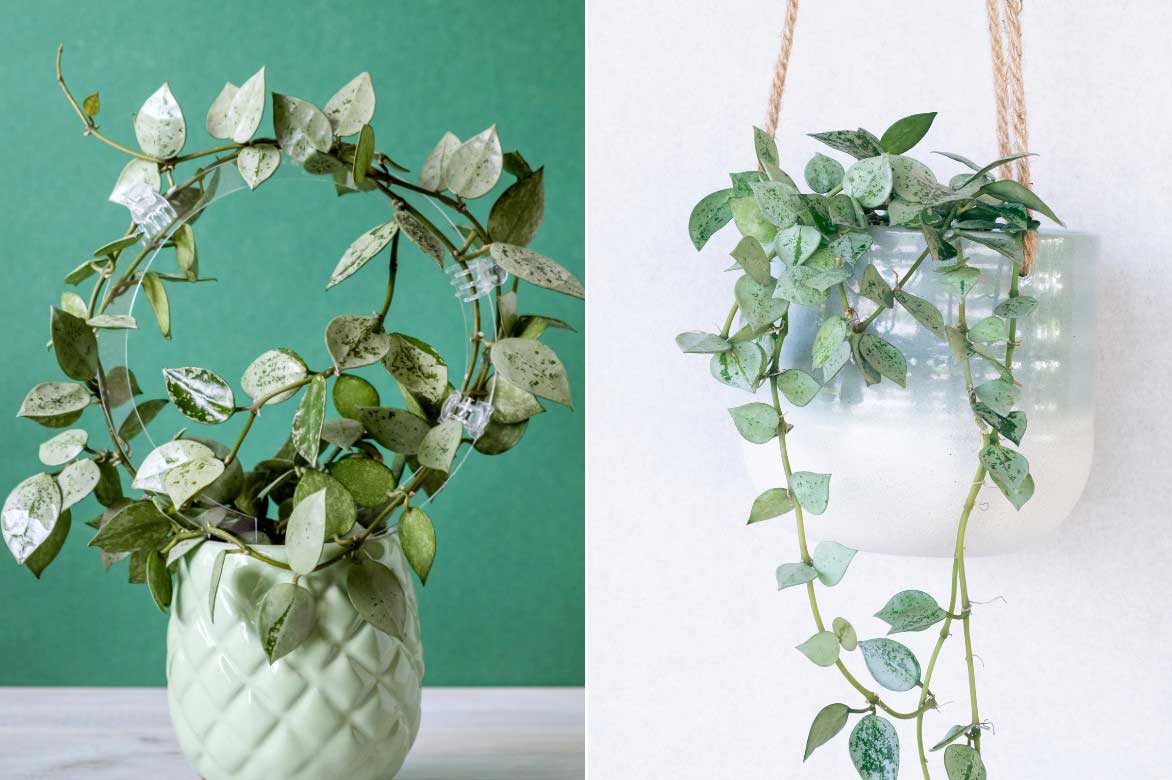
You can train the Hoya’s stems to climb a support or let them trail if grown in a hanging planter!
→ Discover our wide range of houseplants.
- Subscribe!
- Contents
































Comments